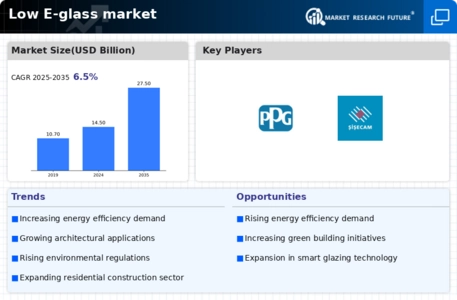Low E Glass Size
Low E Glass Market Growth Projections and Opportunities
The Low E (Low Emissivity) Glass market is influenced by a range of factors that significantly impact its growth and development. To understand the dynamics of this industry, it's essential to explore the critical market factors shaping the Low E Glass market. Here are the key factors presented in a clear and concise pointer format: Energy Efficiency Mandates: The increasing emphasis on energy efficiency in buildings, driven by environmental concerns and governmental mandates, is a key factor influencing the Low E Glass market. Low E Glass is designed to minimize heat transfer through windows, contributing to energy conservation and reduced heating and cooling costs in buildings. Rising Construction Activities: The demand for Low E Glass is closely tied to the overall growth of construction activities. As the construction industry expands globally, the need for energy-efficient building materials, including Low E Glass, grows to meet the requirements of sustainable and green building practices. Stringent Building Codes and Standards: Stringent building codes and energy performance standards set by regulatory authorities influence the adoption of Low E Glass. Compliance with these standards becomes a crucial factor for architects, builders, and developers, driving the integration of energy-efficient glazing solutions. Climate Variations and Seasonal Energy Efficiency: The performance of Low E Glass is particularly beneficial in regions with varying climates. The glass helps regulate indoor temperatures by blocking UV rays and reflecting infrared heat, making it attractive in areas with both hot summers and cold winters. Advancements in Coating Technologies: Ongoing advancements in coating technologies contribute to the growth of the Low E Glass market. Innovations in coating materials and application processes enhance the effectiveness of Low E coatings, improving their solar control and insulating properties. Government Incentives and Rebate Programs: Government incentives and rebate programs promoting energy-efficient solutions play a pivotal role in the adoption of Low E Glass. Financial incentives provided to builders and property owners encourage the implementation of energy-efficient glazing solutions in both residential and commercial construction. Awareness of Environmental Sustainability: Increasing awareness of environmental sustainability influences consumer preferences and industry practices. Low E Glass, known for its contribution to reducing carbon footprints and energy consumption, aligns with the sustainability goals of both businesses and consumers. Residential and Commercial Construction Trends: Trends in residential and commercial construction influence the demand for Low E Glass. The growing popularity of energy-efficient and green building designs contributes to the integration of Low E Glass in windows and facades. Market Competition and Price Dynamics: Market competition among manufacturers of Low E Glass affects pricing dynamics. The availability of cost-effective Low E Glass solutions can drive market penetration, especially in price-sensitive construction projects. Technological Integration in Smart Buildings: The integration of Low E Glass in smart building technologies enhances its appeal. Low E Glass can be incorporated into smart windows that dynamically adjust to changing environmental conditions, contributing to the overall efficiency and comfort of smart buildings.



 Source: Primary Research, Secondary Research, Market Research Future Database and Analyst Review
Source: Primary Research, Secondary Research, Market Research Future Database and Analyst Review


Leave a Comment